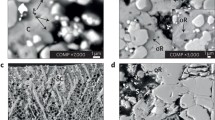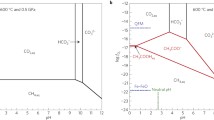Abstract.
This review focuses on the solubility, origin, abundance, and degassing of carbon dioxide (CO2) in magma–hydrothermal systems, with applications for those workers interested in intrusion-related deposits of gold and other metals. The solubility of CO2 increases with pressure and magma alkalinity. Its solubility is low relative to that of H2O, so that fluids exsolved deep in the crust tend to have high CO2/H2O compared with fluids evolved closer to the surface. Similarly, CO2/H2O will typically decrease during progressive decompression- or crystallization-induced degassing. The temperature dependence of solubility is a function of the speciation of CO2, which dissolves in molecular form in rhyolites (retrograde temperature solubility), but exists as dissolved carbonate groups in basalts (prograde). Magnesite and dolomite are stable under a relatively wide range of mantle conditions, but melt just above the solidus, thereby contributing CO2 to mantle magmas. Graphite, diamond, and a free CO2-bearing fluid may be the primary carbon-bearing phases in other mantle source regions. Growing evidence suggests that most CO2 is contributed to arc magmas via recycling of subducted oceanic crust and its overlying sediment blanket. Additional carbon can be added to magmas during magma–wallrock interactions in the crust. Studies of fluid and melt inclusions from intrusive and extrusive igneous rocks yield ample evidence that many magmas are vapor saturated as deep as the mid crust (10–15 km) and that CO2 is an appreciable part of the exsolved vapor. Such is the case in both basaltic and some silicic magmas. Under most conditions, the presence of a CO2-bearing vapor does not hinder, and in fact may promote, the ascent and eruption of the host magma. Carbonic fluids are poorly miscible with aqueous fluids, particularly at high temperature and low pressure, so that the presence of CO2 can induce immiscibility both within the magmatic volatile phase and in hydrothermal systems. Because some metals, including gold, can be more volatile in vapor phases than coexisting liquids, the presence of CO2 may indirectly aid the process of metallogenesis by inducing phase separation.
Similar content being viewed by others
Author information
Authors and Affiliations
Additional information
Electronic Publication
Rights and permissions
About this article
Cite this article
Lowenstern, J.B. Carbon dioxide in magmas and implications for hydrothermal systems. Min Dep 36, 490–502 (2001). https://doi.org/10.1007/s001260100185
Received:
Accepted:
Issue Date:
DOI: https://doi.org/10.1007/s001260100185




